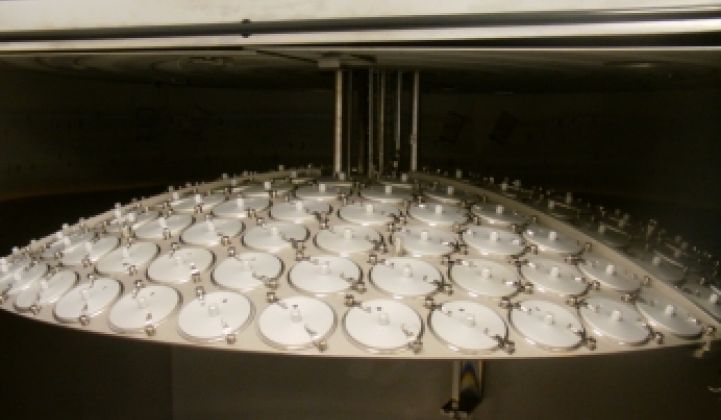Livermore, Calif.--To outfit a house with LED bulbs today could cost around $2,500, according to Bill Watkins, CEO of Bridgelux, at the ribbon-cutting ceremony that took place at the company's manufacturing facility here.
"It will be down to $200 in three years," he added.
Businesses will benefit from this price drop, too. A company that retrofitted its commercial real estate with LEDs might see a payoff in energy savings in about seven years, Watkins said. Three years from now, that will drop to less than two years.
LEDs will also begin to offer "spectrally competent light", i.e., lighting with tunable color accents. You can't do that with a regular bulb.
The opening of the Bridgelux facility comes at a crucial juncture for lighting and the U.S. high tech industry as a whole. Technological advancements, policy mandates, decreasing LED prices and rising electrical prices are prompting a shift in the lighting industry from incandescent and fluorescent bulbs (the last vestige of the vacuum tube industry) toward solid state lights like LEDs. Cree, one of the more established LED makers, opened its own wafer production facility today, as well, in North Carolina.
Philips, Osram, General Electric and many large Asian conglomerates have or will soon begun to crank out new, cheaper LED bulbs for homes and offices. Other companies to watch include Lighting Science (LED bulbs), Intematix (chemical phosphors for making white LEDs) Digital Lumens (industrial LED lamps and networking) and Redwood Systems (networks for LEDs).
But who will become the leader in this industry? Although the U.S. remains a leader in research and venture capital, it has fallen behind in manufacturing, and political discord at the national level is delaying the creation of a comprehensive energy and production strategy, said several speakers. The Bridgelux chip manufacturing facility, in fact, is one of the few fabs built in Silicon Valley in decades. (Below, you can find videos of the factory tour. The picture comes from the inside of one of Bridgelux's chemical deposition chambers.)
"If we are going to continue to lead, we are going to have to make it in America," said U.S. Congressional Representative John Garamendi. "We have to make sure manufacturing grows. We are not going to get past the current recession if we don't make it in America."
Garamendi put forth a few ideas for turning it around in an interview. Cities and states, for instance, could insert provisions requiring contractors that do business with them to get a certain percentage of their solar panels or LED bulbs from U.S.-based facilities. The facilities could be owned by foreign entities, but the materials would be made in the U.S.
Eliminating taxes on manufacturing equipment installed in U.S. facilities would also encourage manufacturers to build plants here. Other nations offer similar incentives. Another idea: accelerated depreciation on factory equipment.
Unfortunately, every time he has tried to include provisions like this in national legislation, it has been vetoed.
"We get zero support from Republicans," he said. "It is short sighted."
"This is more important than jobs," added Watkins. "This is a phenomenal opportunity to create an industry around energy efficient lighting."
ADDED BONUS: The factory tour. So you've always wanted to go to an LED factory. If you can't make it out to tour a facility in person, here are some things you might see. Here is a video showing how Bridgelux lays down the basic materials on its wafer:
And now, the inside of a chemical deposition chamber.
Finally, lithography robots.



